Saturday
Community ArticlesThe Power of Ceremony
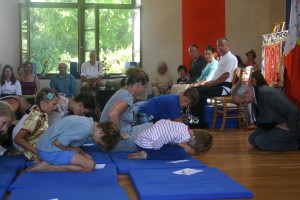 COLUMN: Youth and Families
COLUMN: Youth and Families
Celebrating Rites of Passage
article by Leslie Gossett, column host
photos by Liesbeth Scholten, Amsterdam
…[T]hrough our view, contemplation, and activity, every day we are transforming commonly held internal principles into an external social reality…. The power of ceremony is that through the rituals of our day, we understand who we are.
~ Sakyong Mipham Rinpoche, from The Shambhala Principle
We spend plenty of time thinking about creating culture, and every thing we do is part of that. When we have these commonly held principles, how do we pass them on?
We can begin with our children. We nurture and foster these principles, sharing them, cultivating them, giving the gift that they are to the youngest people we know. For they are the ones who will carry them forth and let them shine.
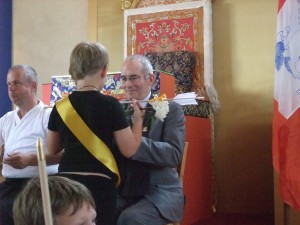 One of the ways we do this in Shambhala is through the Rites of Passage ceremony. This precious program is an opportunity to honor the transition children make into being individual members of society. Practices like kyudo (Japanese archery), calligraphy, and meditaiton are formally introduced. Children are presented with tools they can use to cultivate their own well being. Just such a program was recently held at Dechen Choling, in central France. A diverse group of children, speaking several different languages all came together to experience the power of ritual. I had the great honor to speak with Acharya David Schneider, preceptor, and Liesbeth Scholten, coordinator.
One of the ways we do this in Shambhala is through the Rites of Passage ceremony. This precious program is an opportunity to honor the transition children make into being individual members of society. Practices like kyudo (Japanese archery), calligraphy, and meditaiton are formally introduced. Children are presented with tools they can use to cultivate their own well being. Just such a program was recently held at Dechen Choling, in central France. A diverse group of children, speaking several different languages all came together to experience the power of ritual. I had the great honor to speak with Acharya David Schneider, preceptor, and Liesbeth Scholten, coordinator.
I asked Acharya Schneider about the vision of children and families in Shambhala.
“There is a societal view of Shambhala which the Sakyong keeps encouraging us to embrace. The point is that without children you have a one generation society. If you’re thinking long term, you need to think about what you do with children, how you educate them. You specifically need to think about culture, Shambhala or vajrayana, and how that kind of thing is passed along. Being an American living in Germany and raising a child here, it becomes obvious how German culture is passed along – through language, rituals, opportunities – everything has an educational basis. Kids take on everything, learn from everything. There are various rituals at certain times, particularly the first day of school,or the first day of high school. The family takes the day off and accompanies the kids to school, etc. Cultural values are transmitted through ceremony, language, and what’s taught as important.”
As to why Acharya Schneider spends time doing programs like Rites of Passage:
“I’m interested in passing along the wisdom of the Shambhala culture to subsequent generations because I’ve been living Buddhist culture all my life. It is important for children to get this on a cellular levels, rather than through [Shambhala training] levels and dathuns, etc. Kids in our world have a chance to hear about what we do from people actually doing it. That’s why I wanted to teach Rites of Passage.”
Reflecting upon her time there, Liesbeth gives us a glimpse of the magic of what unfolded.
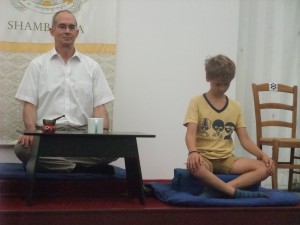 “Some of the highlights of the Rites of Passage program for me were the perception exercises we did with the children outdoors on the Rigden path. There is a beautiful spot with high trees, a lot of mossy green ground and a distant view of the fields through the forest. Here David led us through 10 minutes of standing meditation while paying attention to hearing. On another day we explored the visual perceptions, taking 10 minutes to turn 360 degrees paying attention to seeing. After several exercises opening up the sense perceptions, the children made poems together, inspired by their perceptions and feelings.
“Some of the highlights of the Rites of Passage program for me were the perception exercises we did with the children outdoors on the Rigden path. There is a beautiful spot with high trees, a lot of mossy green ground and a distant view of the fields through the forest. Here David led us through 10 minutes of standing meditation while paying attention to hearing. On another day we explored the visual perceptions, taking 10 minutes to turn 360 degrees paying attention to seeing. After several exercises opening up the sense perceptions, the children made poems together, inspired by their perceptions and feelings.
sticks crackling on the ground
wind shaking the leaves
I never thought we’d get here
Müde
Der Schmetterling auf der Erde
Krächzende Krähe
Gouden vliegjes dansen in het zonlicht
Krekels tsjirpen in het gras
Ik mis mijn zus in de maan
“A favorite activity of the children was making their own bow and arrow. This actually takes several days and starts in the forest cutting the appropriate wood, followed by several carving sessions. The children were really able to handle their own pocket knives well and we saw some beautifully decorated bows come into being. Stringing the bows is always an exciting moment, as there is a risk that the bow will break, but all bows turned out to be flexible enough. A big moment was on the Kyudo platform where the children were guided by four Kyudo practitioners in the first shot ceremony. All parents, siblings and others were watching their introduction to this magical warrior practice.
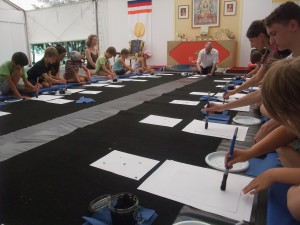 “Another powerful practice was calligraphy. The children helped with setting up the space, which resulted into a very crisp, clean and clear setup, and the children – already trained through handling weapons (knife, bow and arrow) really tuned into the discipline of working with dangerous materials, in this case brushes and black ink!
“Another powerful practice was calligraphy. The children helped with setting up the space, which resulted into a very crisp, clean and clear setup, and the children – already trained through handling weapons (knife, bow and arrow) really tuned into the discipline of working with dangerous materials, in this case brushes and black ink!
“We practiced sitting meditation every day, and here – like with adults beginning to meditate – we saw great variation in the way children experienced it, like boredom, distraction, peacefulness, relaxation. It turned out that sitting with David in front of the other children seemed to lead to a deeper meditative experience so the cushion next to the umdze seat was really in demand.
“The Rites of Passage ceremony on the final day was a beautiful and touching event. The children gave away something from early childhood, they took a warrior’s vow and received ceremonial gifts representing their own warrior qualities. The elements of space, water, earth, fire and air were presented to the children through dance and music in a magical performance. The shrine room was decorated with the flower arrangements made by the children. The whole Dechen Choling community had come to witness the Rites of Passage of these young warriors and to enjoy the uplifted atmosphere. It was so fresh, a new beginning of life’s journey and there was a strong connection with basic goodness.”
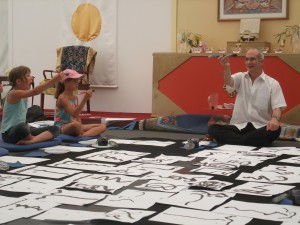 The power of ceremony is tangible in a context such as this one. Acharya Schneider spoke of a couple of children who had some difficulty connecting to the teachings during the program, but that the moment they walked in front of the gathering at the final ceremony, “they were stunned into the recognition that they were doing something serious and real.” One of them confessed it was the best day of his life. There is much to say about the wisdom of the ceremony. Acharya Schneider explains that “putting kids in the public space with their elders, parents, and community around them, makes them feel part of something. Ritual is powerful in that way – ritual as condensed interaction, tremendous focus on a few very simple actions. It is important that things are marked with ceremony. It can be scary to go into a space of not knowing exactly what’s happening, and this is all in the container of a positive ceremony: giving something away, bowing to and turning from your parents – a ritual enactment of leaving a phase of their life and entering another phase. To do that in front of a shrine and audience is extraordinarily powerful.”
The power of ceremony is tangible in a context such as this one. Acharya Schneider spoke of a couple of children who had some difficulty connecting to the teachings during the program, but that the moment they walked in front of the gathering at the final ceremony, “they were stunned into the recognition that they were doing something serious and real.” One of them confessed it was the best day of his life. There is much to say about the wisdom of the ceremony. Acharya Schneider explains that “putting kids in the public space with their elders, parents, and community around them, makes them feel part of something. Ritual is powerful in that way – ritual as condensed interaction, tremendous focus on a few very simple actions. It is important that things are marked with ceremony. It can be scary to go into a space of not knowing exactly what’s happening, and this is all in the container of a positive ceremony: giving something away, bowing to and turning from your parents – a ritual enactment of leaving a phase of their life and entering another phase. To do that in front of a shrine and audience is extraordinarily powerful.”
There is great importance placed on the community participating in these types of ceremonies, whether members have their own children or not. It’s just like that – it really does take a village. How can we cultivate that strong sense of confidence in our culture? By being a part of it. We can claim our shared human experience, our heritage of richness, our cultural rites.
Rites of Passage is offered during Family Camps at land centers, and also on occasion locally. Northern California will offer this wonderful program in spring of 2014. Contact your local center to find out more.
















